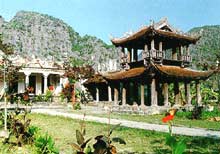 Cao Tan, a researcher from the Heritage Section of the provincial Department of Culture, Sports and Tourism, said an excavation discovered a layer of red sediment containing animal bones and the shells of fresh-water mollusks such as mountain and stream snails.
Cao Tan, a researcher from the Heritage Section of the provincial Department of Culture, Sports and Tourism, said an excavation discovered a layer of red sediment containing animal bones and the shells of fresh-water mollusks such as mountain and stream snails.They are a sure sign of the presence of human beings living in the cave in the late Pleistocene period, more than 10,000 years ago, said Tan.
The findings included assorted shells of marine mollusk such as barnacles and oysters belonging to the Holocene epoch dating to between 5,000 and 7,000 years ago.
Based on this, archaeologists surmise that the Son Cave since may have served as shelter for prehistoric humans with different living environments at two different stages of history.
In the first stage, the surrounding environment was marked by limestone mountains and fresh water streams and springs, while the later stage was characterised by seas and lagoons caused by the expansion of the sea during the Holocene era.
Local archaeologists, however, acknowledged that the real significance of the find could only be determined after thorough research by experts.
The Son Cave is located within the historic site of the ancient capital Hoa Lu under King Dinh Tien Hoang, the founder of the second Vietnamese dynasty, from 968-979.